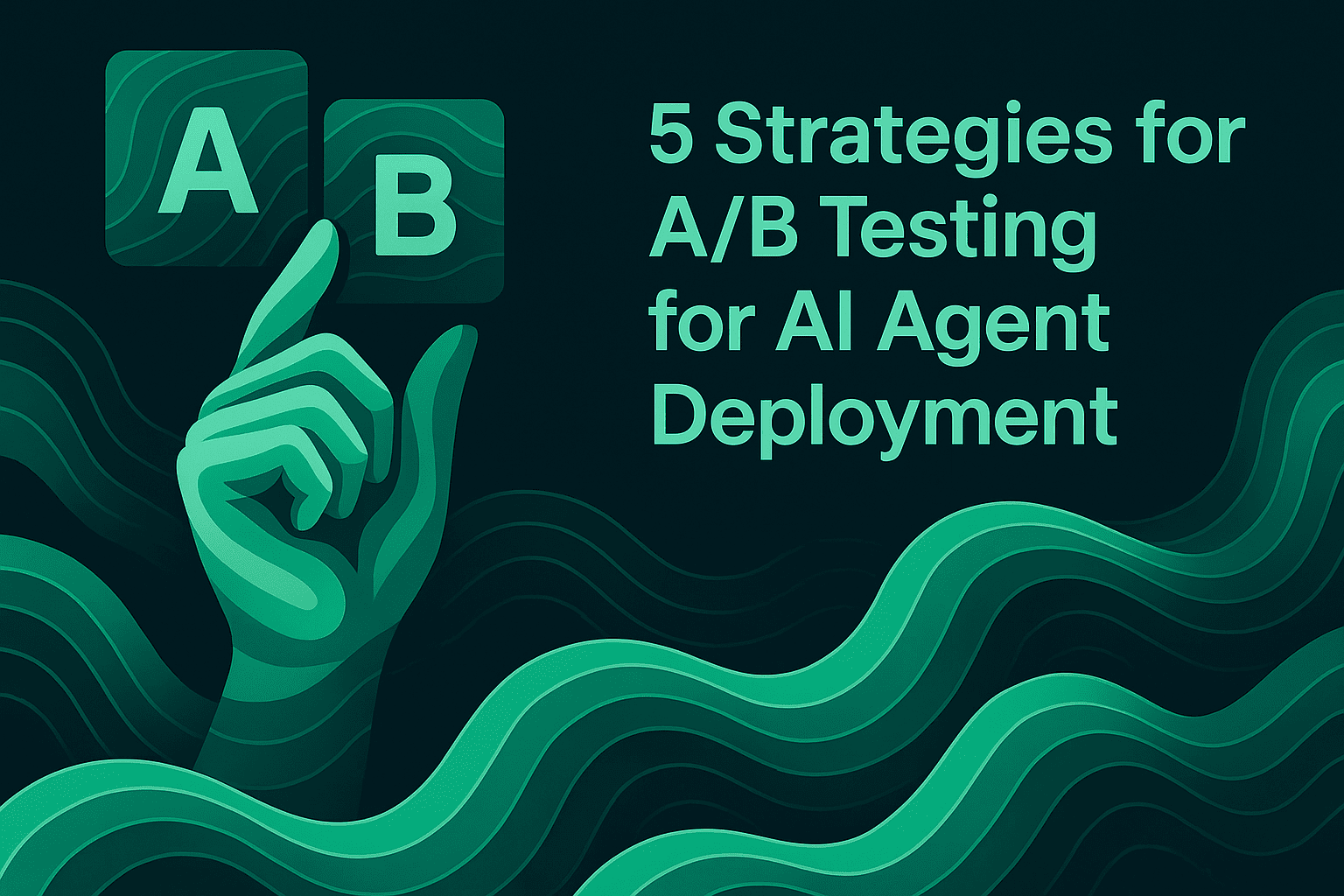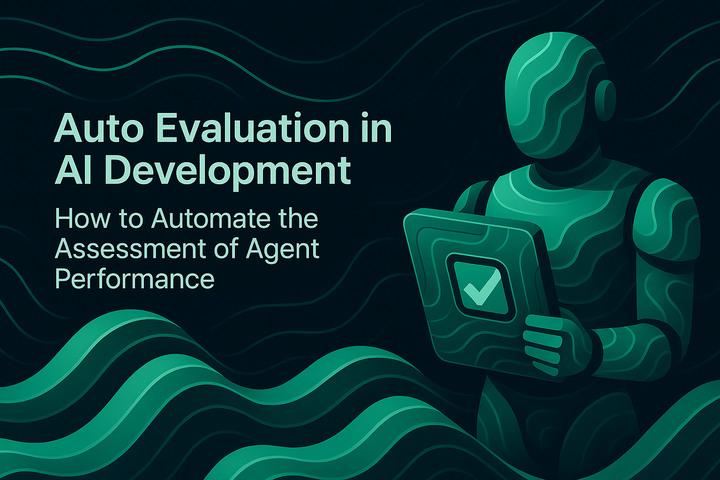Iterative Development of AI Agents: Tools and Techniques for Rapid Prototyping and Testing

TL;DR
Building reliable AI agents requires disciplined iteration through simulation, evaluation, and observability. This guide outlines a practical workflow: simulate multi-turn scenarios with personas and realistic environments, evaluate both session-level outcomes and node-level operations, instrument distributed tracing for debugging, and curate production cases into test datasets. By closing the loop between experimentation and production, teams ship agents faster while maintaining quality, safety, and performance standards.
Building reliable AI agents requires more than clever prompts. It requires a disciplined loop of prototyping, simulation, evaluation, and observability. In practice, this means designing in short cycles, validating behavior with evaluations, capturing granular traces for debugging, and feeding production signals back into test suites to prevent regressions. This article outlines a practical, engineering-first workflow for rapid prototyping and testing, grounded in simulation, evaluation, and observability. It draws on publicly documented capabilities in Maxim AI and industry-standard approaches to agent development, with links to primary sources for deeper reading.
Why Iteration Matters for Agent Reliability
Modern agents orchestrate models, memory, retrieval, and tool calls across multi-step workflows. They must maintain state across turns, use the right tools with correct parameters, and respond consistently under changing evidence. Small changes to prompts, retrieval pipelines, or tool schemas often produce outsized effects on downstream quality. Iteration reduces risk by validating each change against scenario-based tests and production-like conditions.
With Maxim AI, teams connect pre-release experimentation to production through distributed tracing, automated evaluations, and dataset curation. These capabilities support repeatable checks for task success, safety adherence, latency, and cost at the session and node levels. For an overview of platform features across experimentation, simulation, and observability, see Maxim Docs.
Multi-Turn Simulation: Realistic Scenarios That Uncover Failure Modes
Simulation is the backbone of rapid prototyping. Instead of one-shot prompts, multi-turn simulations mirror real conversations, tool usage, and varied personas. They expose failure modes such as context drift, poor trajectory choices, fragile tool invocation patterns, and gaps in policy handling.
Core elements of credible simulations:
- Personas define intent, tone, domain familiarity, and tolerance for ambiguity, ensuring coverage across user types.
- Scenarios specify goals, constraints, preconditions, and expected terminal states, including common, edge, and adversarial cases.
- The environment state model evolves context across turns, including retrieval outputs and tool health.
- Tool stubs introduce deterministic and stochastic returns, timeouts, and schema drift for realistic error handling.
- Evaluators score session-level outcomes and node-level steps, blending deterministic checks with LLM-as-judge for qualitative criteria.
Maxim's approach pairs a synthetic virtual user with your agent, runs sessions until success or max turns, logs every LLM call and tool invocation, and computes metrics like trajectory compliance, PII leakage, latency, and cost. For simulation and evaluator capabilities, refer to the platform documentation.
Evaluation in the Loop: Quantify Change, Catch Regressions, and Protect Quality
Evaluations make iteration evidence-based. In practice, you measure both outcomes and process:
Session-level signals:
- Task success against explicit criteria
- Trajectory quality
- Consistency across turns
- Recovery behavior
- Safety adherence
- End-to-end latency and cost
Node-level signals:
- Tool call validity and parameter correctness
- Retries and backoff
- Guardrail triggers and handling
- Retrieval precision/recall when using RAG
- Step utility toward scenario goals
A unified approach combines deterministic rules, statistical metrics, and LLM-as-a-judge. Deterministic checks catch schema adherence and exact behaviors. Statistical methods detect pattern shifts and drift. LLM-as-a-judge helps evaluate qualitative dimensions like clarity or helpfulness when ground truth is limited. For a deeper dive into when and how to apply LLM-as-a-judge evaluators in agentic workflows, see this article on ensuring reliable and efficient AI evaluation.
When integrated into CI and release gates, evaluations provide pass/fail thresholds and trend analysis. Teams run smoke suites for each change set, nightly broader suites, canary checks before promotion, and scheduled runs to catch regressions. Linking these runs to prompt and model versions keeps quality trends visible and actionable. Explore Maxim's docs for configuring evaluations and interpreting run reports.
Distributed Tracing: Make Debugging and Root Cause Analysis Reproducible
Observability connects what the agent did to why it did it. Distributed agent tracing creates a complete audit trail:
- Traces capture the end-to-end request journey.
- Spans track granular operations, including planning, retrieval, tool calls, and generation.
- Generations log model prompts, parameters, outputs, token usage, and latency.
- Sessions group related traces for multi-turn analysis across conversation history.
For tool-calling agents, observability must show tool selection decisions, parameter generation, execution results, and error propagation. With structured tool call logging, teams can pinpoint whether a failure is due to intent classification, prompt constraints, parameter formatting, or external system errors. This visibility enables targeted remediation rather than broad guesswork.
Closing the loop means curating production cases into datasets, promoting high-value scenarios into a golden set, and expanding them into parameterized families that cover ambiguity, degraded tools, and stale knowledge. Over time, this turns incident learning into proactive test coverage. See the docs for observability architecture, logging patterns, and evaluation on live logs.
Use evaluation layers at both session and node levels. This lets you measure trajectory quality, tool use accuracy, and retrieval relevance. Attach evaluators to specific spans for tool calls, and to full sessions for end-to-end task success.
Tools That Accelerate Iteration: From Prompts to Gateways
Rapid prototyping and testing benefit from a consistent toolchain that supports versioning, comparison, and orchestration:
Prompt management and versioning: Organize and compare prompt variants across models and parameters. Track cost, latency, and quality changes over time. Tie variants to simulations and evaluations for rigorous A/B decisions. Explore experimentation workflows in the docs.
Agent frameworks to production: Instrument agents for session, trace, and span-level logging early, not after deployment. This simplifies debugging and reproduction of failures across environments. Use consistent schemas for tool inputs and outputs to improve evaluator precision.
AI gateway and model routing: A high-performance gateway makes multi-provider access, automatic failover, and load balancing practical, while semantic caching reduces cost and latency for repeated queries. For Maxim's gateway product, review Bifrost documentation, including unified interface, provider support, and observability features.
These tools align engineering and product teams on a single source of truth for quality signals, speeding iteration without sacrificing reliability.
Trace granularity helps recreate failures exactly, from tool call parameters to generation latencies, so teams can replay and isolate issues in minutes, not days.
A Practical Iteration Playbook
Follow this loop to prototype quickly and de-risk changes:
- Define scenarios and personas that reflect your critical user journeys, including edge and ambiguous conditions.
- Instrument tracing across session, trace, and span, and model generations to capture decisions, parameters, and outcomes.
- Configure evaluators spanning deterministic rules, statistical metrics, and LLM-as-a-judge where qualitative judgments matter.
- Run smoke simulations on each change, then nightly suites for broader coverage, and canaries before release. Compare against the last stable baseline.
- Curate production traces into datasets, promote representative failures into the golden set, and expand scenario families to sustain coverage as your system evolves.
- Monitor in production with alerts tied to quality regressions, latency envelopes, and evaluator violations. Re-run scheduled tests to catch drift early.
- Iterate prompts, retrieval, and tool schemas with side-by-side evaluations and cost/latency analysis. Promote winning versions with clear thresholds.
For implementation details and product capabilities across experimentation, simulation, evaluation, and observability, start with the documentation hub.
A Quick Iteration Loop Checklist:
✅ Define personas and scenarios
✅ Attach layered evaluators
✅ Instrument tracing early
✅ Run smoke + nightly + canary tests
✅ Curate datasets from production
✅ Track cost, latency, quality, and reliability
✅ Re-run on change, compare to stable baseline
Conclusion
Iterative development of AI agents works when simulation, evaluation, and observability operate as one system. Multi-turn, persona-driven simulations reveal the issues you miss with single-turn tests. Evaluations quantify change and protect against regressions. Distributed tracing and structured tool logging make debugging fast and reproducible. A consistent toolchain for prompt management and gateways connects pre-release experimentation to production quality.
Teams that formalize this loop ship agents faster and more reliably. To see how Maxim AI operationalizes this workflow across experimentation, simulation, evaluation, and observability, request a demo or get started free.
Request a demo: https://getmaxim.ai/demo
Sign up: https://app.getmaxim.ai/sign-up


